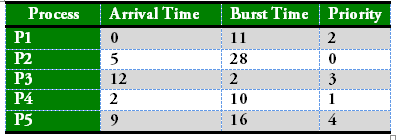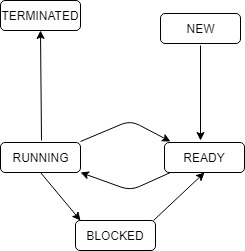OS Process Management
Question 41
If the time-slice used in the round-robin scheduling policy is more than the maximum time required to execute any process, then the policy will
Question 42
Consider the following C code for process P1 and P2. a=4, b=0, c=0 (initialization)
P1 P2
if (a < 0) b = 10;
c = b-a; a = -3;
else
c = b+a;
If the processes P1 and P2 executes concurrently (shared variables a, b and c), which of the following cannot be the value of ‘c’ after both processes complete?
Question 43
Which of the following actions is/are typically not performed by the operating system when switching context from process A to process B?
Question 44
In a computer system where the \'best-fit\' algorithm is used for allocating \'jobs\' to \'memory partitions\', the following situation was encountered:
 When will the 20K job complete?
Note - This question was subjective type.
When will the 20K job complete?
Note - This question was subjective type.
 When will the 20K job complete?
Note - This question was subjective type.
When will the 20K job complete?
Note - This question was subjective type.Question 45
A concurrent system consists of 3 processes using a shared resource R in a non-preemptible and mutually exclusive manner. The processes have unique priorities in the range 1.....3, 3 being the highest priority. It is required to synchronize the processes such that the resource is always allocated to the highest priority requester. The pseudo code for the system is as follows.
Shared Data mutex:semaphore = 1:/* initialized to 1*/ process[3]:semaphore = 0; /*all initialized to 0 */ R_requested [3]:boolean = false; /*all initialized to false */ busy: boolean = false; /*initialized to false */
Code for processes
begin process
my-priority:integer;
my-priority:=____; /*in the range 1...3*/
repeat
request_R(my-priority);
P (proceed [my-priority]);
{use shared resource R}
release_R (my-priority);
forever
end process;
Procedures
procedure request_R(priority);
P(mutex);
if busy = true then
R_requested [priority]:=true;
else
begin
V(proceed [priority]);
busy:=true;
end
V(mutex);
Give the pseudo code for the procedure release_R.Question 48
Which of the following is/are not shared by all the threads in a process?
I. Program Counter II. Stack III. Registers IV. Address space
Question 49
Consider the set of processes with arrival time(in milliseconds), CPU burst time (in milliseconds), and priority(0 is the highest priority) shown below. None of the processes have I/O burst time.
 The waiting time (in milliseconds) of process P1 using preemptive priority scheduling algorithm is ____.
The waiting time (in milliseconds) of process P1 using preemptive priority scheduling algorithm is ____.
 The waiting time (in milliseconds) of process P1 using preemptive priority scheduling algorithm is ____.
The waiting time (in milliseconds) of process P1 using preemptive priority scheduling algorithm is ____.Question 50
The following are some events that occur after a device controller issues an interrupt while process L is under execution.
(P) The processor pushes the process status of L onto the control stack.
(Q) The processor finishes the execution of the current instruction.
(R) The processor executes the interrupt service routine.
(S) The processor pops the process status of L from the control stack.
(T) The processor loads the new PC value based on the interrupt.
Which of the following is the correct order in the which the events above occur?
There are 115 questions to complete.
Last Updated :
Take a part in the ongoing discussion
